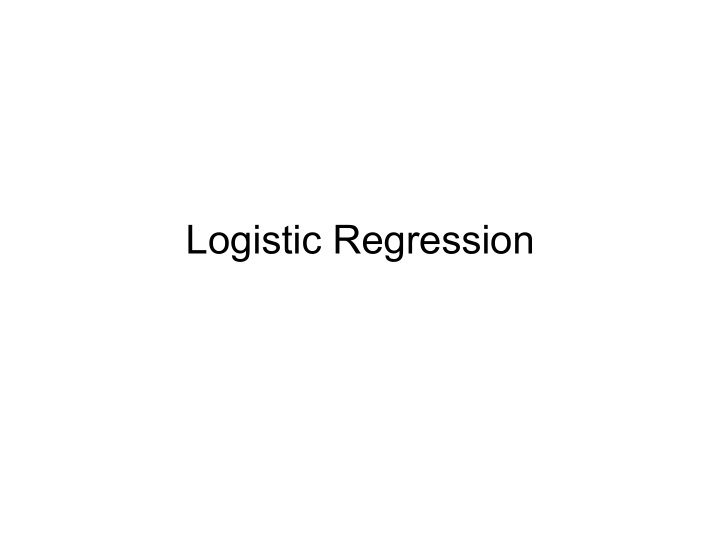



Logistic Regression
Think about this… Rosinex Nausea Ganclex Nausea No Nausea Rosinex Ganclex 81 9 Rosinex No Ganclex 9 1 No Rosinex Ganclex 1 9 No Rosinex No Ganclex 90 810
Rosinex Both Relative Risks are big! Nausea Ganclex Nausea No Nausea Nausea No Nausea Rosinex 90 10 Ganclex 82 18 No Rosinex 91 819 No Ganclex 99 811 RR = (90/100)/(91/910) RR = (82/100)/(99/910) = 9.0 = 7.5 Nausea No Nausea Rosinex Ganclex 81 9 Rosinex No Ganclex 9 1 No Rosinex Ganclex 1 9 No Rosinex No Ganclex 90 810
Rosinex Need a conditional analysis Nausea Ganclex Rosinex users… Rosinex non-users… Nausea No Nausea Nausea No Nausea Ganclex 81 9 Ganclex 1 9 No Ganclex 9 1 No Ganclex 90 810 RR = (81/90)/(9/10) RR = (1/10)/(90/900) = 1.0 = 1.0 “ Holding Rosinex constant, the RR for Ganclex and Nausea is 1 ” Nausea No Nausea Rosinex Ganclex 81 9 Rosinex No Ganclex 9 1 No Rosinex Ganclex 1 9 No Rosinex No Ganclex 90 810
Another perspective Pr(MI) "bad drug" dose
Another perspective Pr(MI) "bad drug" dose more drug…less chance of MI. Bad drug is good???
Another perspective daily aspirin no daily aspirin Pr(MI) "bad drug" dose bad for aspirin users, bad for non-users! Need a conditional analysis
Multiple Regression does this Start with simple regression…
Multiple Regression does this Start with simple regression… sbp = 100.7 + 0.53 x age
From Simple to Multiple… sbp = 83.5 + 0.53 x age + 0.57 x bmi
Multiple Regression Coefficients sbp = 83.5 + 0.53 x age + 0.57 x bmi e.g. 46-year old with bmi=25: 83.5 + (0.53 x 46) + (0.57 x 25) = 122.13 46-year old with bmi=26: 83.5 + (0.53 x 46) + (0.57 x 26) = 122.70 Difference = 0.57 “ on average, sbp increases 0.57 every time bmi increases by 1, holding age constant ”
Multiple Regression Coefficients sbp = 83.5 + 0.53 x age + 0.57 x bmi e.g. 50-year old with bmi=25: 83.5 + (0.53 x 50) + (0.57 x 25) = 124.25 50-year old with bmi=26: 83.5 + (0.53 x 50) + (0.57 x 26) = 124.82 Difference = 0.57 “ on average, sbp increases 0.57 every time bmi increases by 1, holding age constant ” (doesn ’ t actually matter which particular age)
Multiple Regression Coefficients nausea = 0.1 + 0.8 x rosinex + 0.0 x ganclex effect of rosinex holding ganclex constant effect of ganclex holding rosinex constant • nausea, rosinex, and ganclex are zero-one variables in this analysis • interactions?
nausea 0.0 0.2 0.4 0.6 0.8 1.0 120 130 140 sbp 150 160
On to Logistic Regression Could build a model for the probability of nausea… Pr(nausea) = 0.1 + 0.8 x rosinex + 0.07 x sbp …but, in general, the right hand side could be bigger than 1 or negative if some drugs have a protective effect
On to Logistic Regression Could build a model for the odds of nausea… Pr(nausea) = 0.1 + 0.8 x rosinex + 0.07 x sbp Pr(no nausea) …but, in general, the right hand side could be negative if some drugs have a protective effect How about log(odds)?
On to Logistic Regression Pr(nausea) log = -2.2 + 4.4 x rosinex + 0.0 x ganclex Pr(no nausea) Now the prediction is meaningful no matter what the values of the regression coefficients But the model no longer predicts nausea - it predicts the log odds of nausea For someone taking rosinex the predicted log odds of nausea is -2.2 + 4.4 = 2.2 For someone not taking rosinex the predicted log odds of nausea is -2.2
How to Unravel Log Odds For someone taking rosinex the predicted log odds of nausea is 2.2 Pr(nausea) log = 2.2 Pr(no nausea) Pr(nausea) ! = exp(2.2) 1-Pr(nausea) ! Pr(nausea) = exp(2.2) - exp(2.2) x Pr(nausea) ! Pr(nausea) = exp(2.2)/(1+ exp(2.2)) = 0.9
Logistic Regression Coefficients Pr(nausea) log = -2.2 + 4.4 x rosinex + 0.0 x ganclex Pr(no nausea) “ 4.4 is the amount by which the log odds of nausea goes up when someone takes ganclex holding everything else constant ” ! ! positive coefficient odds increases probability goes up
Binary and Continuous Predictors log Pr(nausea) = -2.2 + 0.3 x age + 4.4 x ganclex Pr(no nausea) Pr(nausea) age
More on Coefficients ! coefficient large predictor strongly discriminates between nausea and no nausea Pr(nausea) nausea ! coefficient small predictor weakly discriminates between nausea and no nausea Pr(nausea)
Maximum Likelihood Logistic Regression Typically estimate the coefficients via “ maximum likelihood ” Suppose you want to estimate α and β in this model: Pr(nausea) log = α + β x rosinex Pr(no nausea) using these data:
Maximum Likelihood Logistic Regression e.g., if α = - 0.22 and β = 1 then: e.g., if α = - 0.42 and β = 2.1 then: Idea: pick the values of α and β that maximize the probability of the nausea outcomes you actually saw!
Logistic Regression in Practice • SAS, R, etc. do maximum likelihood logistic regression • Nice statistical properties; works well in most applications • Truly large-scale applications with thousands of drugs require “ regularized logistic regression ” aka lasso and ridge logistic regression • glm(y~x1+x2, data=foo, family=binomial)
Boar <- read.table("/Users/dbm/Documents/W2025/ZuurDataMixedModelling/Boar.txt",header=TRUE) B1 <- glm(Tb~LengthCT,data=Boar,family=binomial) summary(B1) MyData <- data.frame(LengthCT = seq(from = 46.5, to = 165,by = 1)) Pred <- predict(B1, newdata = MyData, type = "response") plot(x = Boar$LengthCT, y = Boar$Tb) lines(MyData$LengthCT, Pred) ParasiteCod<- read.table("/Users/dbm/Documents/W2025/ZuurDataMixedModelling/ParasiteCod.txt",header=TRUE) ParasiteCod$fArea <- factor(ParasiteCod$Area) ParasiteCod$fYear <- factor(ParasiteCod$Year) Par1 <- glm(Prevalence ~ fArea * fYear + Length, family=binomial, data=ParasiteCod) summary(Par1) missing values?
Recommend
More recommend